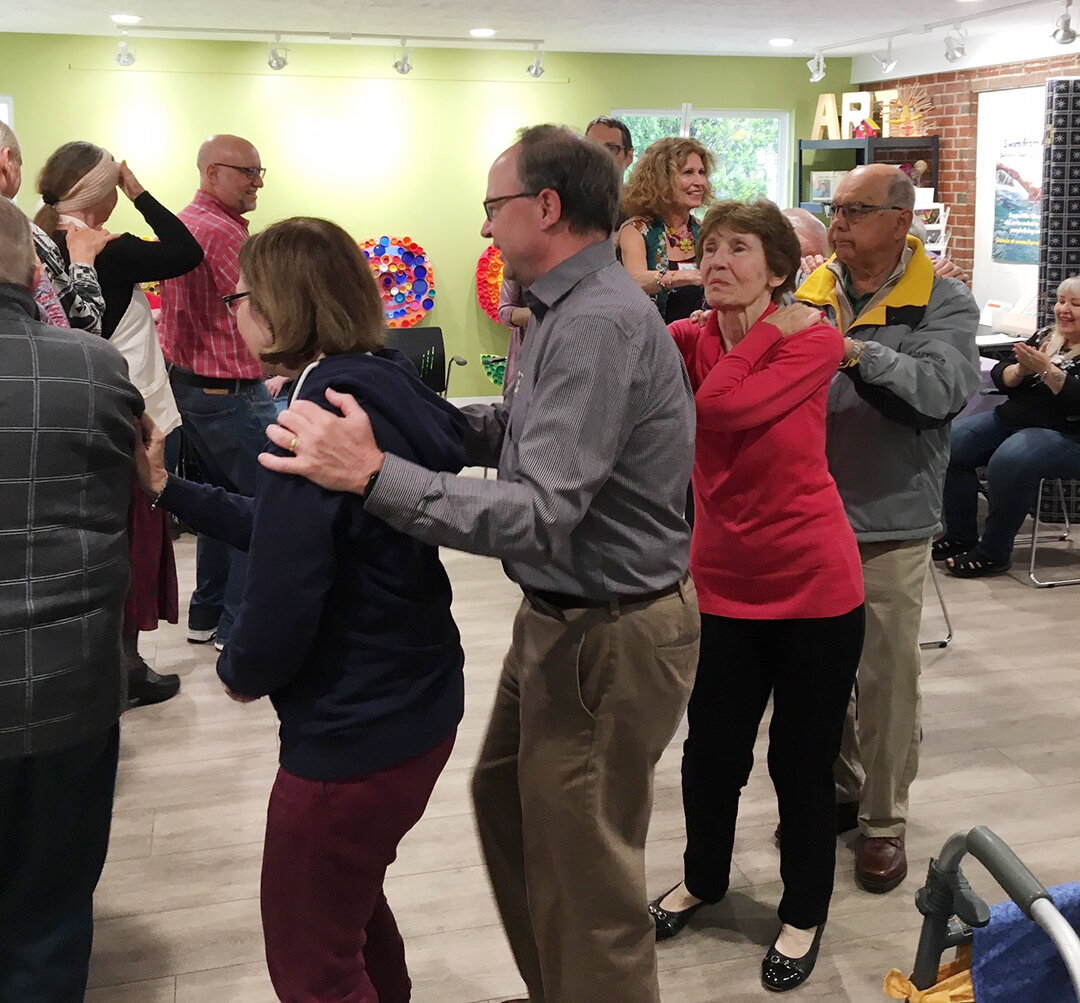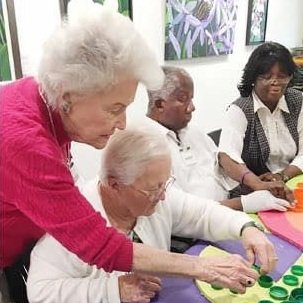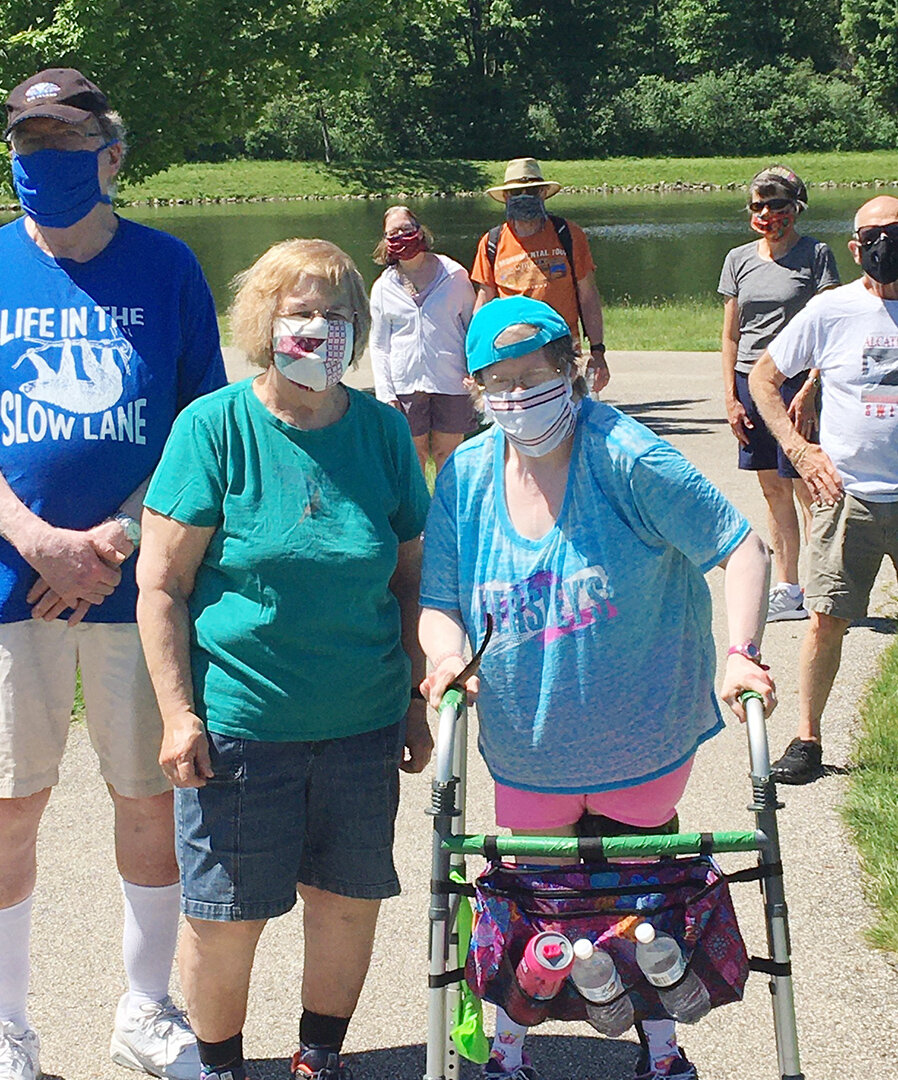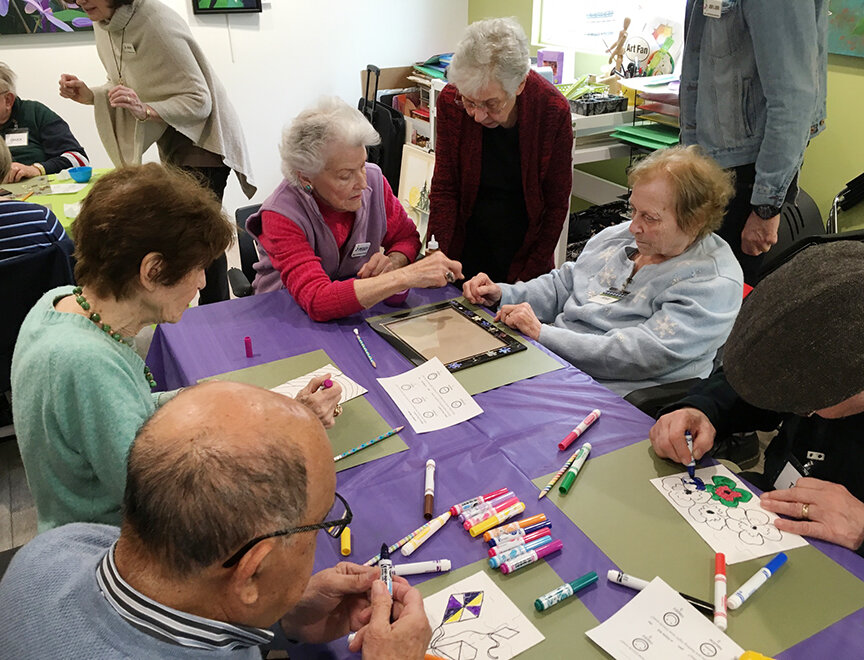Stories of Impact
Carolyn L. Farrell Foundation for Brain Health
LIVING WELL WITH DEMENTIA: UNCONVENTIONAL APPROACH HELPS CLOSE HEALTH CARE GAPS
It wasn’t far into their journey with dementia when the Farrell family recognized the power of arts enrichment programs and its positive impact on the health and well-being of those living with a brain illness. Today, their efforts bring joy and comfort to individuals and caregivers across the greater west side communities and beyond through the Carolyn L. Farrell Foundation for Brain Health, named in honor of their late wife and mother who passed away in 2015 after a ten year journey with Lewy Body dementia. Carolyn was a mother to five and friend to many, with a wide circle of interests and passions. At the onset of her diagnosis, Carolyn knew she faced cognitive decline after seeing her mother suffer through the same functional loss years earlier. Despite the challenges ahead and with a shared determination to be together, they agreed to care for one another at home. Dementia would eventually impact Carolyn’s ability to communicate but not her ability to engage in activities that brought peace and enjoyment with the help of her family.
The inspiration for the Farrell Foundation evolved when Carolyn’s husband, Dr. Charles Farrell (“Dr. Charlie”), a retired vascular surgeon and their daughter, Reverend Katie Norris realized they had a unique opportunity to help others affected by dementia after discovering a lack of support and programming that encouraged social interaction and networking. Subsequent research led them to learn about various art forms and its effectiveness as an alternative method of expression and communication. In 2011, six years after Carolyn’s initial diagnosis, the Farrell Foundation was launched with a mission to enrich families touched by brain health issues through the arts, socialization and community outreach. “Emotionally, the loss of words for Carolyn was frustrating but through various art forms and creative expressions such as reacting to colors, the rhythm of music or a dance, she was able to find ways to communicate with us,” shares Dr. Charlie.
Approximately 5.8 million people in the U.S. are living with dementia with that number expected to increase as the elderly population grows. According to the Alzheimer’s Association, one in eight baby boomers will experience some form of dementia after they turn 65. At age 85 that risk increases to nearly one in two. And if they don’t have it, chances are they will likely be caring for someone who does. Dementia is not a specific disease but rather an umbrella used to describe a set of symptoms that include loss of memory, language, problem-solving and other thinking abilities that are severe enough to interfere with daily life. Four common forms of clinical dementia includes Alzheimer’s disease, currently the most common and country’s sixth-leading cause of death, along with Vascular dementia (post-stroke), Lewy Body dementia (dementia with Parkinson’s) and Frontotemporal dementia. Since each type of dementia can affect people differently, individuals will experience symptoms in their own way. “Understanding the unique perspective of an individual affected by dementia can help ensure the care partner is able to address both physical and emotional needs,” states Dr. Charlie.
For those living with dementia and other brain health issues the functional progression and social stigma associated with the diagnosis can shatter one’s identity. “One of the challenges Carolyn faced and prevalent among those we engage with at the Farrell Foundation is the ability to express oneself, whether that’s figuring out a process to determine a forgotten word or reacting to what may be interpreted as impatience verse helpfulness from the caregiver,” comments Dr. Charlie. A significant part of the Farrell Foundation’s efforts center on providing education that helps well-meaning care partners, families and community members apply forms of communication that avoid the natural tendency to correct mistakes, say “no”, or not present options. Adopting different and respectful approaches that focus on the positive verse the negative help reduce the anxious or agitated behavior that often stems from frustration when an individual with dementia feels like they’re not part of the conversation. “Using tools other than language makes their world a lot wider,” he says. “People can communicate forever if they use their imagination to share what makes sense to them without being automatically corrected.” This is where the Farrell Foundation is making a difference.
The Farrell Foundation’s home is the Center for Artful Living in Westlake where arts enrichment is open to the community and offered at no cost. Programming is designed to include both the individual affected by dementia and the primary caregiver, providing both with the education and support needed to care for each another. According to Dr. Charlie, “People assume individuals with dementia cannot participate in daily life anymore and that’s not true. Isolation is a large contributing factor to the increase of loneliness and failure to thrive.” Equally important, the Farrell Foundation’s unique approach considers the mental and physical well-being of the care partner as well, helping them adjust and balance the impact of dementia on their lives. “Seventy percent of families opt to care for their loved ones at home but tend to have very little support that counterbalances the emotional impact and social stigma,” he adds.
Arts experiences can help maintain the quality of life for those living with dementia by offering enjoyment that is not dependent on memory. Jerry Devis, the Farrell Foundation’s energetic artistic director plans and coordinates an array of unique music, dance and art programming designed to stimulate the senses and create a sense of belonging. “Although they don’t always recall what we did previously, we still introduce a new theme each month that’s tied across all programming,” comments Devis. “It helps put context around a concept, such as Harvest of Colors during October ─ providing a synergistic arts experience and opportunity for conversation.” Devis credits his team and the variety of professionals, guest artists, local musicians/music therapists, storytellers, dance instructors and others that foster an open, friendly and safe atmosphere for expression.
In early 2020, the Farrell Foundation was underway with expanding its enrichment programs and activity-based experiences through a grant awarded by the Three Arches Foundation when the COVID-19 pandemic hit. With the Center for Artful Living closed indefinitely, additional support from Three Arches Foundation through a COVID-19 response grant helped the team mobilize quickly to develop and implement socially distanced and virtual delivery methods. Participants have been able to enjoy interactive and engaging arts programs through a guided Zoom session intended to replicate the onsite social atmosphere of the Center for Artful Living, in tandem with a tactile arts kit pre-mailed to their respective homes. Attendance doubled at the onset of the virtual get-togethers and has kept steady since with many of the programs now appealing to a broader group of participants that were physically unable to attend in-person before the pandemic. Another popular activity is the weekly “Walk, Talk & Roll” where participants join the team for a walk at Westlake Community Park to get outdoors and socialize, followed with a sing-a-long in the gazebo.
Currently in development is a new initiative that expands dementia education and advocacy through the use of improvisation/theatrical art. Video production featuring realistic, day-to-day scenarios that accentuate unrealized and often misunderstood communication barriers will be used as a learning tool with caregivers and through community outreach efforts such as safety forces, first responders, service providers, faith-based organizations, etc. “The stories reflect common situations that emphasize understanding and sincerity,” says Devis. “It’s not always easy to know how to generate positive outcomes but through this visual art medium we can help people reach further using age and dementia-friendly communication techniques.”
The Farrell Foundation looks forward to the day when the Center for Artful Living can reopen and welcome back the community. For now, visitors can enjoy the brand new “Carolyn’s Garden & Gallery” featuring artwork on exhibit from Creative Connections participants, as well as array of talented local artists. Part of the gallery is featured in a beautifully lit display visible during a drive past the building. Visitors are always welcome to stop by, relax on a garden bench and enjoy the serene arts atmosphere from outside. “Dementia is caused by multiple factors and may never be cured, but we can help families by offering care of health education and support that is needed to create an environment to live well and experience happiness, giving them a sense of accomplishment and purpose.” adds Dr. Charlie.
To learn more aboout the Carolyn L. Farrell Foundation for Brain Health visit farrellfoundation.org
Photos courtesy of Carolyn L. Farrell Foundation for Brain Health
Published November 2020







